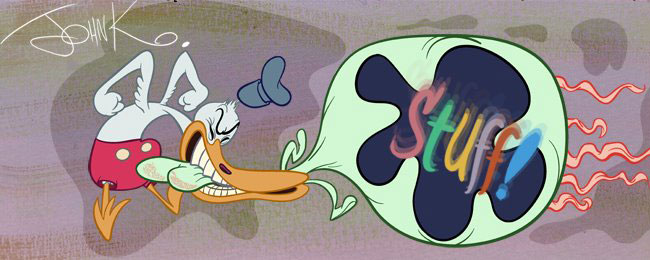KNOWING THE DIFFERENCE BETWEEN GENERAL AND SPECIFIC AND PUTTING IT TO USE CREATIVELY
 Mike has the best toy collection of anyone I know, and all us cartoonists collect toys. He categorizes them carefully too... which is very fun to look at but it's also instructive.When you see a variation on a theme it inspires you to vary your own themes and strive to evolve your style and avoid genericism.
Mike has the best toy collection of anyone I know, and all us cartoonists collect toys. He categorizes them carefully too... which is very fun to look at but it's also instructive.When you see a variation on a theme it inspires you to vary your own themes and strive to evolve your style and avoid genericism. You might think there is only one generic cartoon Indian design, but here are a whole pile of variations on a type, which is just like real life.
You might think there is only one generic cartoon Indian design, but here are a whole pile of variations on a type, which is just like real life. Knowing the difference between a general category and a specific instance of it is the key to understanding just about anything better.
Knowing the difference between a general category and a specific instance of it is the key to understanding just about anything better.Aristotle and Mike are 2 similar types - people who like to classify or categorize, and then collect tons of variations within the category to compare, contrast and see the limits of variation. It's the key to invention.

http://www.tutorvista.com/content/biology/biology-iii/animal-kingdom/animal-classification.php
http://animaldiversity.ummz.umich.edu/site/accounts/pictures/Mammalia.html
Darwin used Aristotle's classification system and figured out how evolution worked by comparing degrees of variation from general wider plans.
Classification is a wonderful observational tool. Maybe you can be the next Darwin, just by learning the same thinking process Mike, Charles and Aristotle use.
 For example, every one of these Indians (like every one of every race or wider - of every species) shares some general traits that separate them from other toys. They also share a trait put there by the artists... they are all fun to look at, they have appeal and humor. This is a trait missing from much of modern art, entertainment and culture.
For example, every one of these Indians (like every one of every race or wider - of every species) shares some general traits that separate them from other toys. They also share a trait put there by the artists... they are all fun to look at, they have appeal and humor. This is a trait missing from much of modern art, entertainment and culture.

But look closer at at a group of individuals and you will find all kinds of differences between them. Some individuals are closer in design to others; some are farther apart.
If they become so far apart that it gets harder to see common general traits, then they become part of a wider group. The farther apart they are, the bigger the group category or class.
 Indians are part of the larger group (species) of humans which belong to the primate order, the class of mammals, the phyla of chordates (animals with backbones), the kingdom of animals and then life itself. The farther back you stand, the more general the groups become.
Indians are part of the larger group (species) of humans which belong to the primate order, the class of mammals, the phyla of chordates (animals with backbones), the kingdom of animals and then life itself. The farther back you stand, the more general the groups become.The closer you look at the groups, the more specific the groups become. The generic idea of Indian can be broken down into tribes, and location.
http://www.mygenealogist.com/native-american-genealogy.htm
 South American Indians share some general visual traits with Eskimos and other Indian groups in between, but less with them than with closer groups.
South American Indians share some general visual traits with Eskimos and other Indian groups in between, but less with them than with closer groups. 
And you can look closer and closer until you finally get right down to the individual -which animation rarely does.
 All these Native Americans share some obvious broad general traits-wide high and angular cheekbones and a very specific kind of nose that's widest at the bottom and pointed downward.
All these Native Americans share some obvious broad general traits-wide high and angular cheekbones and a very specific kind of nose that's widest at the bottom and pointed downward.


 Animated cartoons tend to be very general or "generic". Even more general than the wider group of cartoon art, which includes comic strips, comic books, magazine cartoons and even cartoon toys.
Animated cartoons tend to be very general or "generic". Even more general than the wider group of cartoon art, which includes comic strips, comic books, magazine cartoons and even cartoon toys. Animated cartoons by their nature have to be fairly simple so you can do a lot of drawings in a reasonable amount of time.
Animated cartoons by their nature have to be fairly simple so you can do a lot of drawings in a reasonable amount of time.


 The simpler your drawings, the less individual details you have to vary. That's a reason Disney tends to reuse character designs over and over again. The other reason is of course, conservatism. The more conservative you are, the less you like specific variations. You like to leave things alone.
The simpler your drawings, the less individual details you have to vary. That's a reason Disney tends to reuse character designs over and over again. The other reason is of course, conservatism. The more conservative you are, the less you like specific variations. You like to leave things alone. Personally, as everyone who reads this blog knows, I hate generic - BUT!...I find it useful. Principles are general tools that are useful to all skills. They give us more control and (if we so choose) variation over what we wish to create.
Personally, as everyone who reads this blog knows, I hate generic - BUT!...I find it useful. Principles are general tools that are useful to all skills. They give us more control and (if we so choose) variation over what we wish to create.Just how specific you are depends upon what level of generality you stop creating at.
I don't go for simple stereotypes of any type of character, human or animal. I find them boring. But in order to create specific characters well, you have to be honest and observant enough to see how things look in general first - THEN you can do specific variations.

These toy sculptures show that you can have a wide variety of individual designs, even within a general type.

I think modern political correctness has confused "classification" with "stereotypes" and stereotypes with "evil". All life is organized by traits in common on different levels. Humans even organize themselves on purpose into general stereotypes - like Democrats and Republicans.
Today's democrats think the very idea of observing shared traits in any group of humans means you hate that group - but they get furious if you personally vary from any of the attitudes of their own group beliefs. I am completely baffled by this trendy doctrine. People are too eager to look for things to be offended by today.
When I was a kid, there was much diversity in my neighborhood and everyone recognized it but was not particularly offended by knowing it. I remember being punched in the face once for being a public school kid (which generally meant protestant). I wasn't offended by being stereotyped as a square secular kid. I was offended by the fist crushing my nose, though. And I still had lots of friends from the "Catholic School".
Generalities about my neighborhood when I was a kid: There were 3 schools within 2 blocks of each other. The Public School, The Catholic School and The French School.
The Catholic kids were mostly Italian and were tougher than us. They grew up quicker-they had mustaches and B.O. when they were 12 and looked like men in wrinkly turtlenecks and corduroy pants to us, which we thought was hilarious and frightening. We looked like sissies to them. The English Speaking Catholics - especially Italians - tended to hang around in gangs. Not well organized murderous gangs like today's. These were kids from 8 years old to like...12 or 13. They liked trouble and fought a lot. They had their own unique group gestures, expressions and attitudes - yet within the obvious and funny stereotype, they varied widely.
All the Italian kids wore pointy shoes, which they were ashamed of and everyone else made fun of them. Then they would chase us and teach us what the pointy shoes were for.
The French kids had their own stereotypical types and behaviors. The also saw ours and made fun of them. Everyone basically made fun of everyone else. No one was offended. There were occasional fights, but not too many serious ones. It was all very interesting, colorful, fun and scary. It taught most people growing up realities about social life. All from just natural observation using the faculties that separate humans from animals.
OBSERVANT VS INTOLERANT
Good cartoonists know the difference between being observant and being intolerant. 2 completely unrelated things.
To be an observant artist you have to be able to see broad categories of things (including people). You have to be able to see common traits; in fact you can't help it, your eyes are more developed than the average person- but you also can benefit greatly by seeing the amount of possible variations within a class. You have to have a wide scope of observational faculties. From far away to very close.
Looking at all the possibilities of variation within the group of toy Indians here, you can see a lot of leeway for individual characters and creative expression.
 These are all good sculptures and very true and observant to the general traits of their subject. Yet they are all different.
These are all good sculptures and very true and observant to the general traits of their subject. Yet they are all different.
Why Chief Wahoo is Smiling
http://www.clevelandmagazine.com/ME2/dirmod.asp?sid=E73ABD6180B44874871A91F6BA5C249C&nm=Arts+%26+Entertainment&type=Publishing&mod=Publications%3A%3AArticle&mid=1578600D80804596A222593669321019&tier=4&id=7CA0BB1EC3494C8DA8700A7A11F1C97B
 This Nutty Mad Indian looks like Mike Pataki!
This Nutty Mad Indian looks like Mike Pataki! Here's an Indian that looks like the one in that Art Davis Porky Pig cartoon, "Nothing But The Tooth".
Here's an Indian that looks like the one in that Art Davis Porky Pig cartoon, "Nothing But The Tooth".


Mike sometimes categorizes his toys by what kind of toys they are too. His bobble head collection is amazing! So much better than modern bobble-heads. Look how accurately the sculptor above captured the general features of the Aboriginal Canadians! Even the almond shaped, slightly slanted eyes.
 Extra Treats:
Extra Treats: It seems like other countries don't have the same politically-correct hangups we have in the decadent west. I hope PC blinders disappear from our world soon so cartoonists can be free, creative observant and fun again!
It seems like other countries don't have the same politically-correct hangups we have in the decadent west. I hope PC blinders disappear from our world soon so cartoonists can be free, creative observant and fun again!
 Doesn't this mask above look like the group called "cartoon-writers"?
Doesn't this mask above look like the group called "cartoon-writers"? It's a good thing there are still open minded fellows like Mike to preserve our great creative and observant past.
It's a good thing there are still open minded fellows like Mike to preserve our great creative and observant past.




